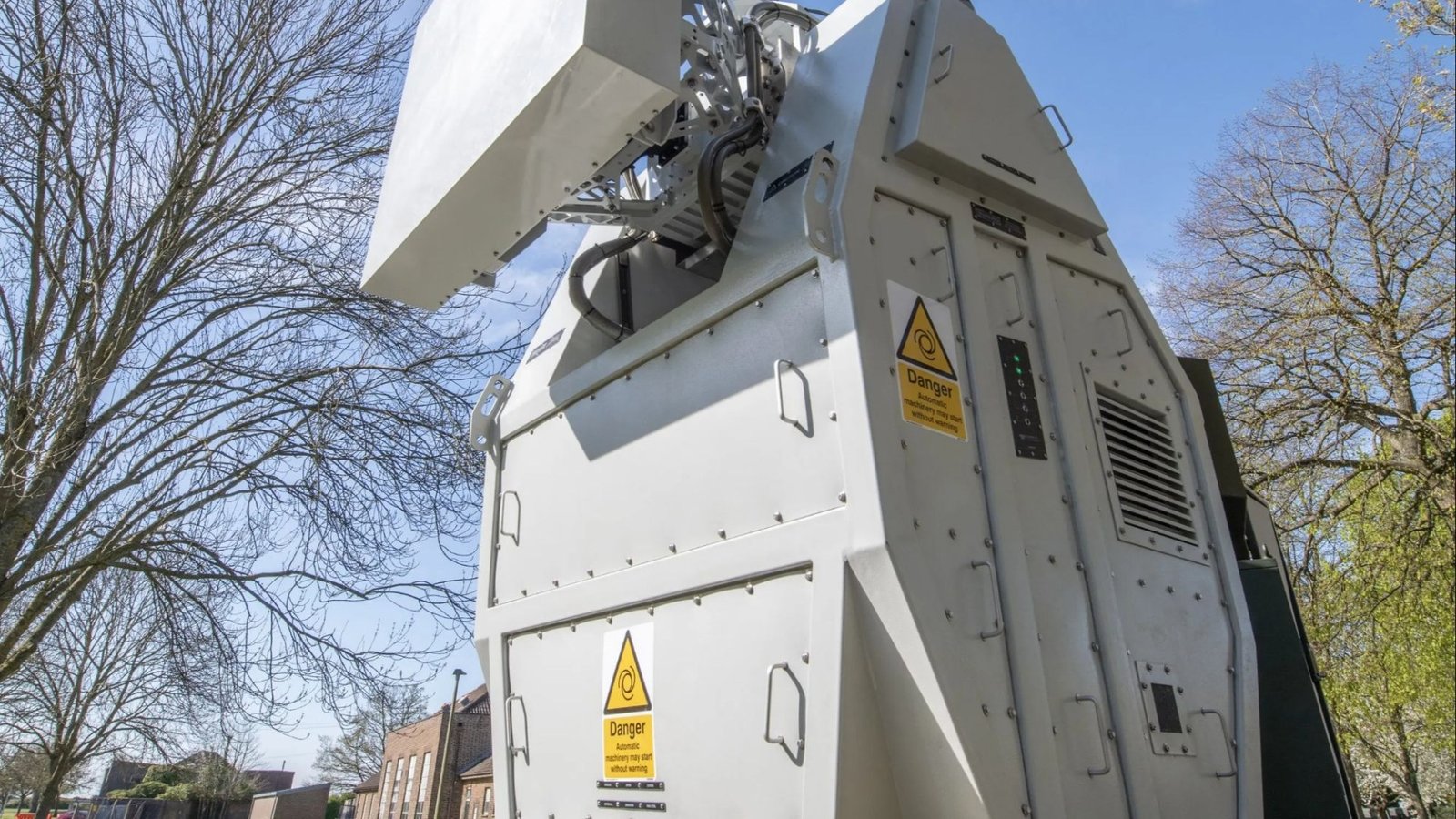BRAND new drone-killer technology designed and built in the UK will see a swarm of robo-planes blasted out of the sky for just 10p a shot.
The game-changing weapon, unveiled by the Ministry of Defence at midnight, is to be used by the UK’s armed forces to disable enemies’ electronics and destroy multiple drones at once.
The technology is currently under development and expected to be used by the UK’s armed forces in the coming years, providing the UK with a “decisive operational advantage”.
It will beam radio waves to disrupt or damage threats across land, air, and sea up to 1km away – although further development is hoped to see its range extended.
An example of a Radio Frequency Directed Energy Weapon (RFDEW), the system will be able to detect, track, and engage enemy vehicles, causing them to come to a grinding halt or fall out of the sky.
The RFDEW beam will be able to down “dangerous drone swarms with instant effect”, according to the Ministry of Defence, at a cost-effective price of 10p per shot fired.
Multiple threats can be engaged at once within the same beam, or a rapid fire of sequenced shots can strike at individual targets.
The technology will be able to be mounted on a variety of different military vehicles and will use a mobile power source to produce pulses of radio frequency energy.
The RFDEW system is a cheaper alternative to traditional missile-based air defence systems and can be operated by a single person.
British weapon “DragonFire” is more expensive at £10p a shot, but is expected to be ready for deployment by 2027 at the latest.
Defence Secretary Grant Shapps hinted last month that it could end up in Ukraine‘s hands even sooner, before they are “100 per cent perfect”, with British soldiers set to test the weapon within weeks.
The DragonFire uses an intense light beam to cut through its target and can strike at the speed of light.
It is designed to shoot down attack drones, missiles, planes, and even satellites with its 50kW beam – and can engage with any visible target as small as a £1 coin.
Tonight’s unveiling of the RFDEW system comes after Prime Minister Rishi Sunak announced an increase to the UK’s defence budget to 2.5 per cent of GDP by 2030.
Defence experts hope the new technology will work to protect and defend the UK’s critical assets and bases.
Minister for Defence Procurement James Cartlidge said: “We are already a force to be reckoned with on science and technology, and developments like RFDEW not only make our personnel more lethal and better protected on the battlefield, but also keep the UK a world leader on innovative military kit.
“The war in Ukraine has shown us the importance of deploying uncrewed systems, but we must be able to defend against them too.
“As we ramp up our defence spending in the coming years, our Defence Drone Strategy will ensure we are at the forefront of this warfighting evolution.”
The new technology – which will be tested in the field by soldiers over the summer – is being developed by a joint team from the Defence Science and Technology Laboratory (Dstl) and Defence Equipment & Support (DE&S).
Both organisations are working with UK industry under Project Hersa.
Dstl Chief Executive, Paul Hollinshead said: “These game changing systems will deliver decisive operational advantage to the UK armed forces, saving lives and defeating deadly threats.
“World class capabilities such as this are only possible because of decades of research, expertise and investment in science and technology at Dstl and our partners in UK industry.”
THE DRAGONFIRE
Soldiers are also set to test the DragonFire laser guns and a new type of radar beam weapon.
The lasers can heat their targets to over 3,000 degrees Celsius in an instant, while the radio weapons work by blasting a pulse of energy which fries electric circuits – causing drones to drop out of the sky.
Both systems were developed at the government’s top secret Porton Down laboratory in Wiltshire and were due to be trialled by troops from the 7th Air Defence Group, based at Thorney Island, Hants.
Matt Cork, the boss of Porton Down’s directed energy weapons demonstration programme, said the radio weapon can destroy “a room full of computers or a telephone exchange”.
It does so by blasting an electro-magnetic pulse that overloads its target’s electrics.
He added: “Anything that has electricity flowing through it, you can disrupt it.”
A version of the radio weapon is to be mounted on a military truck and tested this summer, before the laser weapon is tested by the Royal Artillery in the autumn.
The laser weapon, known as DragonFire, has already been fired from a Royal Navy warship.
The MoD said the DragonFire would be fitted to Royal Navy warships by 2027 at the latest – five years ahead of schedule.
The Sun understands the lasers will be most likely fitted to frigates.
Incredible declassified footage released by the Ministry of Defence in March showed the formidable weapon being used to strike targets in Scotland’s Outer Hebrides.
The video demonstrated the laser’s impressive ability to lock onto a target and destroy it with a powerful beam fired into the sky.
The UK’s new Radio Frequency Direct Energy Weapon system
BY Grant Shapps, Secretary of State for Defence
When Putin’s men killed Dawn Sturgess in Salisbury with Novichok poison, Kremlin cronies pointed the finger at this laboratory.
The Russian tyrant was yet again trying to cover his ruthless violence with fake news.
But we know the truth.
Putin is a threat to us all and must be stopped.
To protect our prosperity, values and freedom, we must be prepared for war now and in the future.
Technology is transforming warfare faster than ever before and if our Armed Forces are to remain fighting fit, they must have the latest and best equipment.
When I visited the Defence and Science and Technology Laboratory at Porton Down last month, I saw the cutting-edge weapons being developed.
They will give us a lethal edge on the modern battlefield.
The Dragonfire laser is due to be fitted on Royal Navy ships in 2027, five years earlier than planned.
We are working hard to have our new Radio Frequency Direct Energy Weapon (RFDEW) system in service in the coming years.
Dragonfire can destroy flying threats at the speed of light, while RFDEW uses electromagnetic energy to disrupt or down drones and other electronic military systems.
Dragonfire operates at just £10 a shot. An RFDEW shot costs only 10p!
We also have military scientists trialling the use of AI to analyse images and identify camouflaged targets and exploring the use of unmanned surveillance aircraft in the stratosphere.
To produce this highly advanced kit of tomorrow, the government is investing in innovation and teaming up with British industry.
We have put UK industry on a war footing with our plan to spend 2.5% of GDP on defence by 2030.
An additional £75 billion will spent over the next six years.
This is the biggest strengthening of defence for a generation, and we have put high-tech innovation at the heart of our plans.
To support programmes like DragonFire and RFDEW, and ensure our Armed Forces have the kit they need and deserve, we will spend at least 5% of the defence budget on research and development.
Companies across the country are tooling up to accelerate production.
I saw this for myself recently in Telford, where the Challenger 3 tank is nearly complete.
This tank is one of the most lethal in the world and the first to be fully British built in more than 20 years.
The UK defence industry supports around 200,000 jobs and the action we have taken will help grow the economy and be felt in communities across the country.
Through our growing defence budget and laser focus on innovation, the UK is standing up to our enemies and showing our allies what we all need to do to be more secure in a more dangerous world.
And it’s our scientists at Porton Down and engineers in British industry who remain our secret weapon.



















